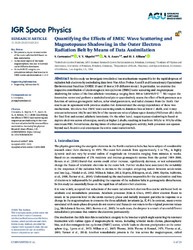Quantifying the Effects of EMIC Wave Scattering and Magnetopause Shadowing in the Outer Electron Radiation Belt by Means of Data Assimilation
DOI: https://doi.org/10.1029/2020JA028208
Persistent URL: http://resolver.sub.uni-goettingen.de/purl?gldocs-11858/9500
Persistent URL: http://resolver.sub.uni-goettingen.de/purl?gldocs-11858/9500
Cervantes, S.; Shprits, Y. Y.; Aseev, N. A.; Allison, H. J., 2020: Quantifying the Effects of EMIC Wave Scattering and Magnetopause Shadowing in the Outer Electron Radiation Belt by Means of Data Assimilation. In: Journal of Geophysical Research: Space Physics, Band 125, 8, DOI: 10.1029/2020JA028208.
 |
View/
|
In this study we investigate two distinct loss mechanisms responsible for the rapid dropouts of radiation belt electrons by assimilating data from Van Allen Probes A and B and Geostationary Operational Environmental Satellites (GOES) 13 and 15 into a 3-D diffusion model. In particular, we examine the respective contribution of electromagnetic ion cyclotron (EMIC) wave scattering and magnetopause shadowing for values of the first adiabatic invariant μ ranging from 300 to 3,000 MeV G−1. We inspect the innovation vector and perform a statistical analysis to quantitatively assess the effect of both processes as a function of various geomagnetic indices, solar wind parameters, and radial distance from the Earth. Our results are in agreement with previous studies that demonstrated the energy dependence of these two mechanisms. We show that EMIC wave scattering tends to dominate loss at lower L shells, and it may amount to between 10%/hr and 30%/hr of the maximum value of phase space density (PSD) over all L shells for fixed first and second adiabatic invariants. On the other hand, magnetopause shadowing is found to deplete electrons across all energies, mostly at higher L shells, resulting in loss from 50%/hr to 70%/hr of the maximum PSD. Nevertheless, during times of enhanced geomagnetic activity, both processes can operate beyond such location and encompass the entire outer radiation belt.
Statistik:
View StatisticsCollection
Subjects:
data assimilationEMIC waves
magnetopause shadowing
innovation vector
Kalman filter
radiation belt losses
This is an open access article under the terms of the Creative Commons Attribution-NonCommercial-NoDerivs License, which permits use and distribution in any medium, provided the original work is properly cited, the use is non-commercial and no modifications or adaptations are made.

